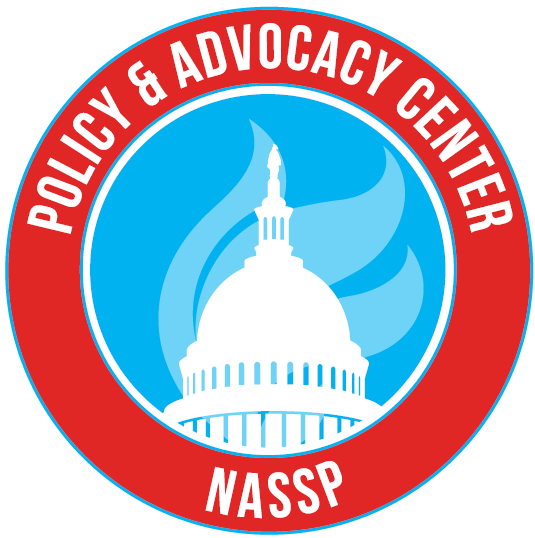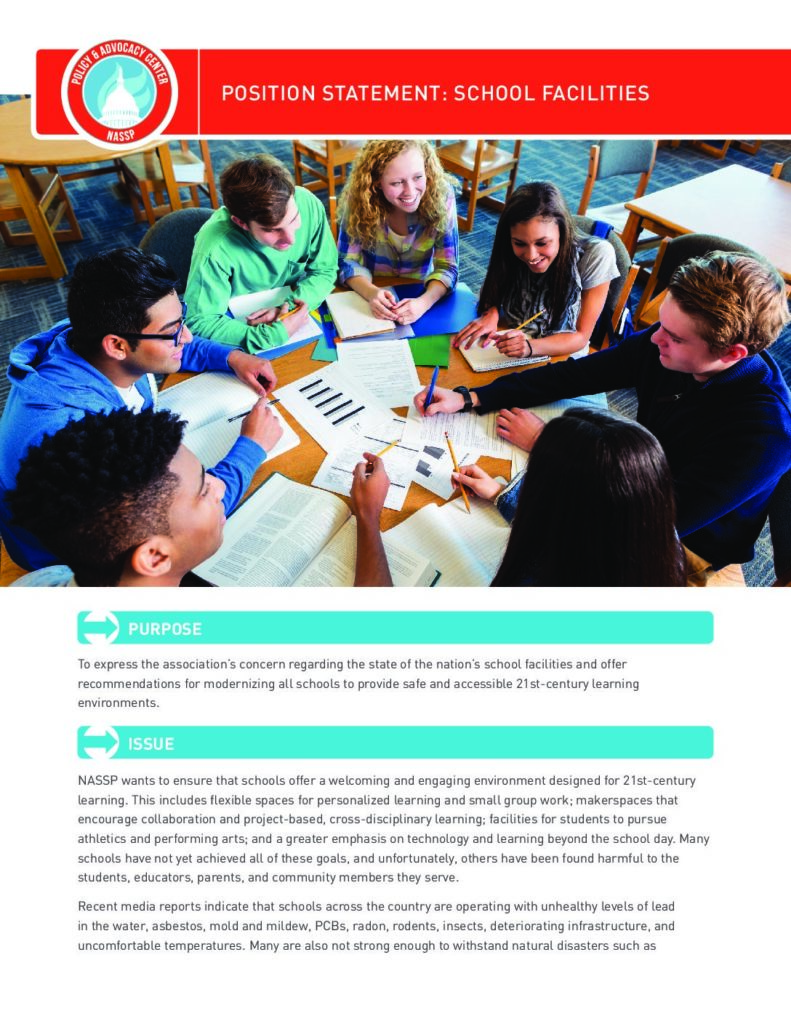To express the association’s concern regarding the state of the nation’s school facilities and offer recommendations for modernizing all schools to provide safe and accessible 21st-century learning environments.
NASSP wants to ensure that schools offer a welcoming and engaging environment designed for 21st-century learning. This includes flexible spaces for personalized learning and small group work; makerspaces that encourage collaboration and project-based, cross-disciplinary learning; facilities for students to pursue athletics and performing arts; and a greater emphasis on technology and learning beyond the school day. Many schools have not yet achieved all of these goals, and unfortunately, others have been found harmful to the students, educators, parents, and community members they serve.

Recent media reports indicate that schools across the country are operating with unhealthy levels of lead in the water, asbestos, mold and mildew, PCBs, radon, rodents, insects, deteriorating infrastructure, and uncomfortable temperatures. Many are also not strong enough to withstand natural disasters such as earthquakes, hurricanes, tornadoes, and floods. While the federal government and states banned many hazardous materials for new school construction in the 1980s, the average school nationwide is 44 years old. School quality impacts recruitment and retention of effective leaders and teachers, student attendance, and the health of the entire school community. In 20 studies analyzed by the 21st Century School Fund, all but one found a positive correlation between student achievement and the condition of the school building when controlling for other student demographic factors.
Unfortunately, very little national data exists about school-building conditions or funding for school modernization and repair. The U.S. Government Accountability Office (then called the General Accounting Office) last released a report in April 1995 on school facilities. It found that more than 8 million students attended schools with poor air quality; 12 million students attended schools in need of new roofs or roof upgrades; and 12 million students attended schools with inadequate plumbing.
A report released in 2016 by the 21st Century School Fund, Inc., the U.S. Green Building Council, Inc., and the National Council on School Facilities estimates that the United States “should be spending about $145 billion per year to maintain, operate, and renew facilities so that they provide healthy and 21st-century learning environments for all children.” However, districts are struggling to finance school modernization and repair efforts while also managing rising enrollments and the need for new school construction. Only five states (CO, CT, KY, MA, and OH) cover a majority of districts’ capital construction costs, 12 states provide no direct support, and the level of support varies in the remaining 33 states. The federal government only contributes minimal funding for school facilities, mostly through grants from the Federal Emergency Management Agency following a national disaster.
Guiding Principles
According to the Professional Standards for Educational Leaders 2015—a guide released by the National Policy Board for Educational Administration—effective leaders seek, acquire, and manage fiscal, physical, and other resources to support curriculum, instruction, and assessment; the student learning community; professional capacity and community; and family and community engagement.
NASSP’s Breaking Ranks: The Comprehensive Framework for School Improvement recommends that the school create a safe, caring environment characterized by interactions between adults and students that convey high expectations, support, and mutual respect.
School leaders and staff members, along with community members and leaders, have a shared responsibility to ensure that schools are safe and orderly.
Ensuring safe, healthy, and modern public school facilities that can support innovative teaching and personalization is a crucial component to closing the achievement gap, increasing academic achievement and graduation rates, and ensuring all students have access to effective teachers and school leaders.
In the position statement on transgender students, NASSP recommends that state policymakers provide funding for new school construction and maintenance that will help schools update their facilities to include gender-neutral restrooms, locker rooms, and shower rooms.
Technology can be a powerful tool to engage all students in their education and can help establish personalized learning environments, as promoted in the Breaking Ranks framework.
As a member of the Coalition for Community Schools, NASSP supports its mission to unite school, community, and family for young people’s success.
Recommendations
Recommendations for Federal Policymakers
- Require the U.S. Government Accountability Office to update the survey, research, and conclusions regarding the physical condition of the nation’s school facilities that were last presented to Congress in 1995.
- Encourage the National Center for Education Statistics to collect data on school facility conditions in its annual Common Core of Data surveys.
- Conduct research on school facilities in other countries, such as Finland, where contemporary campuses are built to meet the pedagogical and social needs of students and educators.
- Explore the feasibility of developing national standards on school building conditions, financing, and investment.
- Permanently extend the Qualified Zone Academy Bonds program to help districts borrow funding at low interest rates to finance school renovation and repair projects.
- Authorize a federal grant program for states to modernize, innovate, renovate, or repair public school facilities to be safe, healthy, high-performing, and technologically up to date.
- Assist schools in conducting risk assessments and provide funding for school safety measures such as intrusion detection, access control, and video surveillance as needed.
- Modify the tax code to create a new private activity bonds category for schools.
- Fully fund the Student Support and Academic Enrichment Grants that may be used by schools for improving the use of technology to personalize learning experiences for all students.
- Provide adequate funding for the E-Rate program to ensure that schools have sufficient broadband capacity to support digital learning in every classroom.
- Reauthorize the Carl D. Perkins Career and Technical Education (CTE) Act to ensure that schools have resources to create makerspaces, upgrade CTE and STEM facilities, and provide professional development for leaders and teachers to make school a relevant and engaging experience for all students.
- Fully fund the Full-Service Community Schools Program to improve the coordination and integration, accessibility, and effectiveness of services for children and families.
Recommendations for State Policymakers
- Adopt the voluntary guidelines developed by the Environmental Protection Agency to establish and implement environmental health programs for K–12 schools.
- Follow the lead of New York by requiring districts to regularly test for lead in the water of the 90 percent of schools that do not have their own water supply.
- Approve legislation aimed at reducing lead in schools, including higher fees for lead-based products, surveys of lead-based infrastructure, and funding for remediation programs.
- Expand state tax credits and matching funds for school repair and modernization projects.
- Explore ways to incentivize partnerships between school districts and municipalities to increase efficiency in maintenance and construction.
- Reduce approval processes and/or backlogs that inhibit timely completion of necessary school construction or modernization projects.
Recommendations for District Policymakers
- Conduct regular inspections of school facilities, including testing for lead in the water and the presence of asbestos, and report this data publicly to educators, parents, and the community.
- Engage in long-term and short-term planning that links conditions of school facilities to learning outcomes in deliberate ways.
- Ensure that schools have adequately trained maintenance staff to ensure the quality of school facilities.
- Provide school leaders and teachers with professional development opportunities to help them lead instructional shifts to make school a relevant and engaging experience for all students.
- Pursue partnerships with institutions of higher education, public parks, and recreation centers to ensure students have access to athletic facilities and performing arts spaces.
- Assist schools in creating flexible spaces that meet the needs of students, educators, parents, and community members such as extended learning areas, office spaces, libraries and media centers, and large multipurpose rooms.
Recommendations for School Leaders
- Document building hazards within your school and health-related complaints from staff and students, and communicate regularly with district officials to ensure conditions have been rectified.
- Educate yourself about the condition of the school infrastructure in your district, particularly discrepancies between schools, and participate in district-level facilities planning.
- If your school was built prior to 1980, familiarize yourself with guidance and tools offered by the U.S. Environmental Protection Agency to ensure the quality of your drinking water.
- Combine efforts to enhance school climate with reasonable physical security measures by:
- Assessing the physical security features of the campus, such as access points to the school grounds, parking lots, and buildings, and the lighting and adult supervision in lobbies, hallways, parking lots, and open spaces;
- Employing environmental design techniques, such as ensuring that playgrounds and sports fields are surrounded by fences or other natural barriers, to limit visual and physical access by non-school personnel; and
- Ensuring that students are well monitored.
- For school leaders wanting to create a makerspace in their schools:
- Understand their students by asking about their interests and hobbies outside of school.
- Assess current programs to determine where there are gaps and how the makerspace activities will align with curriculum and content standards.
- Research global issues that may not be taught in current classes.
- Develop themes that will interest their students and allow them to go deeper with their learning.
Resources
- American Society of Civil Engineers (2013). 2013 report card for America’s infrastructure. Retrieved from http://www.infrastructurereportcard.org/a/documents/Schools.pdf
- Coalition for Community Schools (2014). Community school facilities: Authentic engagement, shared space, and neighborhood hubs. Retrieved from http://www.communityschools.org/assets/1/AssetManager/Community School Facilities Webinar FINAL.pdf
- Cowan, K.C., Vaillancourt, K., Rossen, E., & Pollitt, K. (2013). A framework for safe and successful schools. Bethesda, MD: National Association of School Psychologists.
- Department of Homeland Security (2012). Buildings and infrastructure protection series primer to design safe school projects in case of terrorist attacks and school shootings. Retrieved from https://www.dhs.gov/xlibrary/assets/st/bips07_428_schools.pdf
- Facilities: fairness and effects (2011, July 27). Retrieved from: http://www.21csf.org/csf-home/publications/ImpactSchoolFacilitiesCivilRightsAug2011.pdf
- Filardo, M. (2016). State of our schools: America’s K–12 facilities 2016. Washington, DC: 21st Century School Fund. http://www.21csf.org/best-home/docuploads/pub/331_StateofOurSchools2016.pdf
- Long, C. (2013, March 13). Aging schools create dangerous and fragile learning environments. Retrieved from http://neatoday.org/2013/03/13/aging-schools-create-dangerous-and-fragile-learning-environments-2/
- Lopez, E. (2016, June 16). School lead testing: The race for tighter regulations and more funding. Retrieved from http://www.politico.com/story/2016/06/school-lead-testing-the-race-for-tighter-regulations-and-more-funding-224419
- National Association of Secondary School Principals (2011). Breaking ranks: The comprehensive framework for school improvement. Reston, VA: Author.
- National Policy Board for Educational Administration (2015). Professional standards for educational leaders 2015. Reston, VA: Author.
- Office of Senator Edward J. Markey (2016). The ABCs of PCBs. Retrieved from http://www.markey.senate.gov/imo/media/doc/2016-10-05-Markey-PCB-Report-ABCsofPCBs.pdf
- Roscorla, T. (2016, July 5). 4 steps to planning a successful makerspace. Retrieved from http://www.centerdigitaled.com/k-12/4-Steps-to-Planning-a-Successful-Makerspace.html
- Sparks, Sarah D. (2012, July 6). Finland rethinks factory-style school buildings. Education Week. Retrieved from http://www.edweek.org/ew/articles/2012/07/06/36finland.h31.html?tkn=MWUFVwjmWV11fKHlp8T6tA2KVN+n+oXnGak0&cmp=clp-edweek&print=1
- U.S. Environmental Protection Agency. Lead in drinking water at schools and child care facilities. Retrieved from https://www.epa.gov/dwreginfo/lead-drinking-water-schools-and-child-care-facilities#Schools

